Boohoo Group PLC: A Financial Analysis and Investment Recommendation
VerifiedAdded on 2023/06/12
|8
|1274
|268
Report
AI Summary
This report provides a financial analysis of Boohoo Group PLC, a leading online fashion retailer, with a comparative analysis against its competitor, ASOS Plc. The analysis includes a brief background of Boohoo, an evaluation of its fiscal performance through ratio analysis (gross profit margin, current ratio, gearing ratio, and shareholder's equity), and a comparison with ASOS. The report determines the future performance of Boohoo based on its revenue, international expansion, and brand engagement strategies. Ultimately, the report concludes that investing in Boohoo Group PLC is more favorable than investing in ASOS Plc, citing Boohoo's better financial stability, liquidity position, and overall economic performance based on the provided data and ratio analysis. The analysis considers factors such as debt levels, current liabilities, and asset positions to provide a comprehensive investment recommendation.
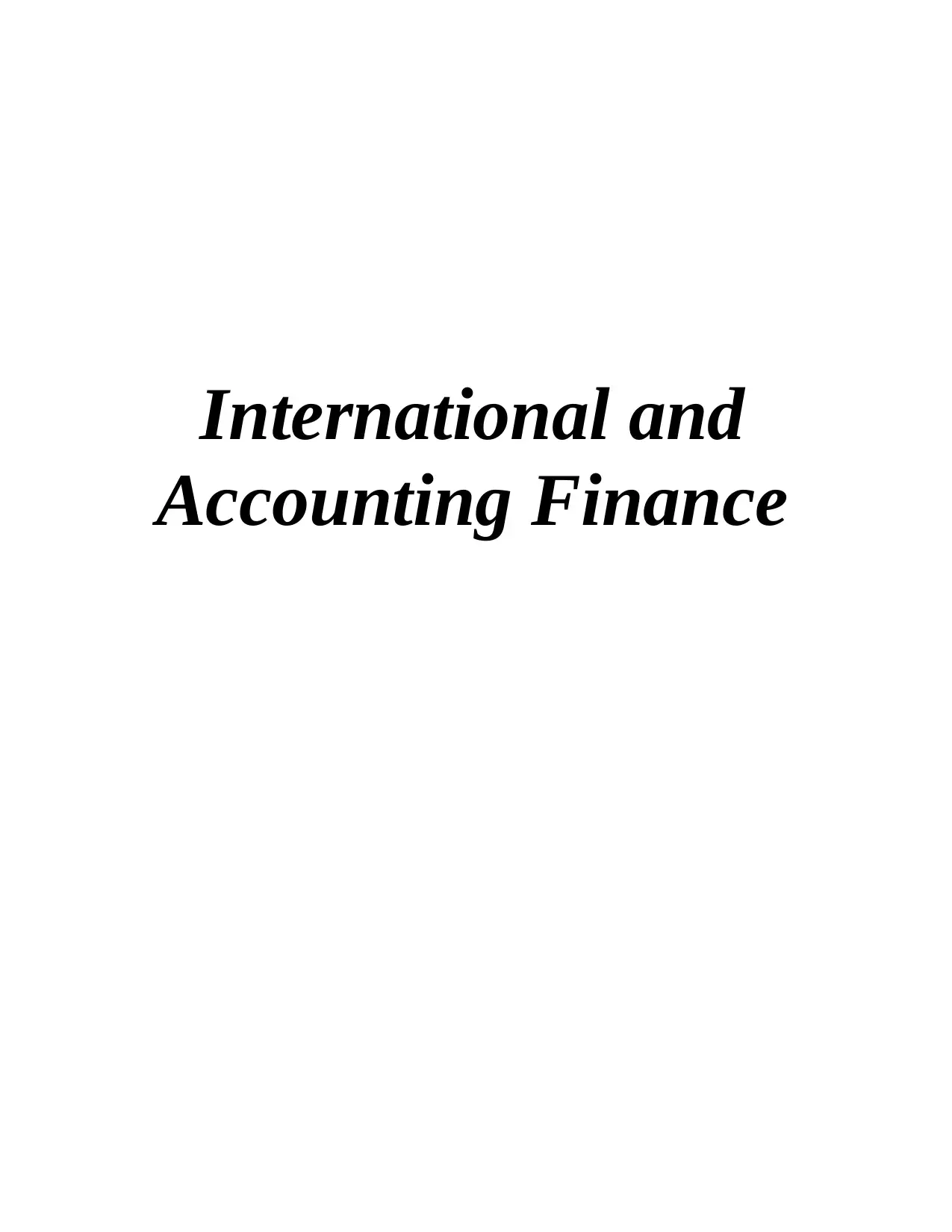
International and
Accounting Finance
Accounting Finance
Paraphrase This Document
Need a fresh take? Get an instant paraphrase of this document with our AI Paraphraser
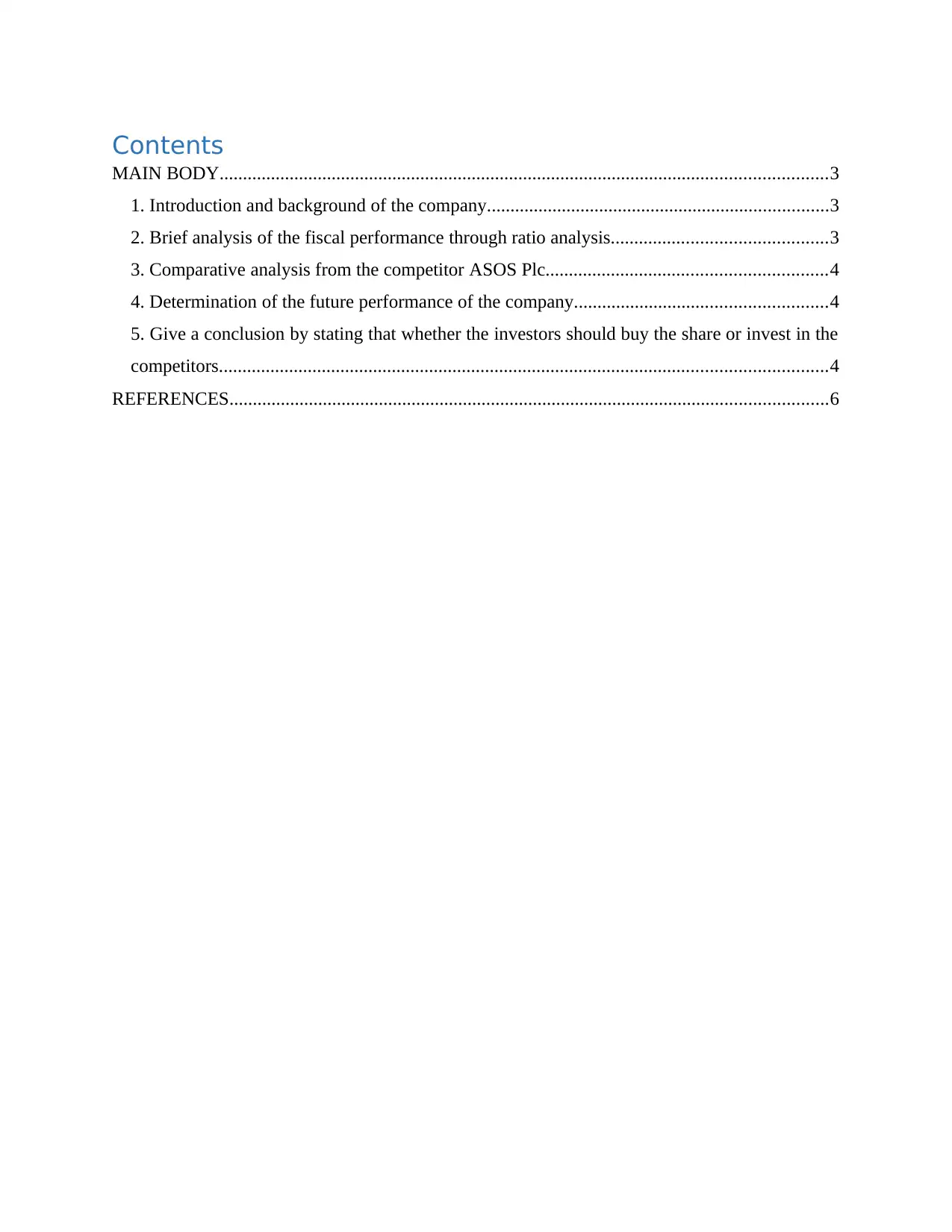
Contents
MAIN BODY..................................................................................................................................3
1. Introduction and background of the company.........................................................................3
2. Brief analysis of the fiscal performance through ratio analysis..............................................3
3. Comparative analysis from the competitor ASOS Plc............................................................4
4. Determination of the future performance of the company......................................................4
5. Give a conclusion by stating that whether the investors should buy the share or invest in the
competitors..................................................................................................................................4
REFERENCES................................................................................................................................6
MAIN BODY..................................................................................................................................3
1. Introduction and background of the company.........................................................................3
2. Brief analysis of the fiscal performance through ratio analysis..............................................3
3. Comparative analysis from the competitor ASOS Plc............................................................4
4. Determination of the future performance of the company......................................................4
5. Give a conclusion by stating that whether the investors should buy the share or invest in the
competitors..................................................................................................................................4
REFERENCES................................................................................................................................6
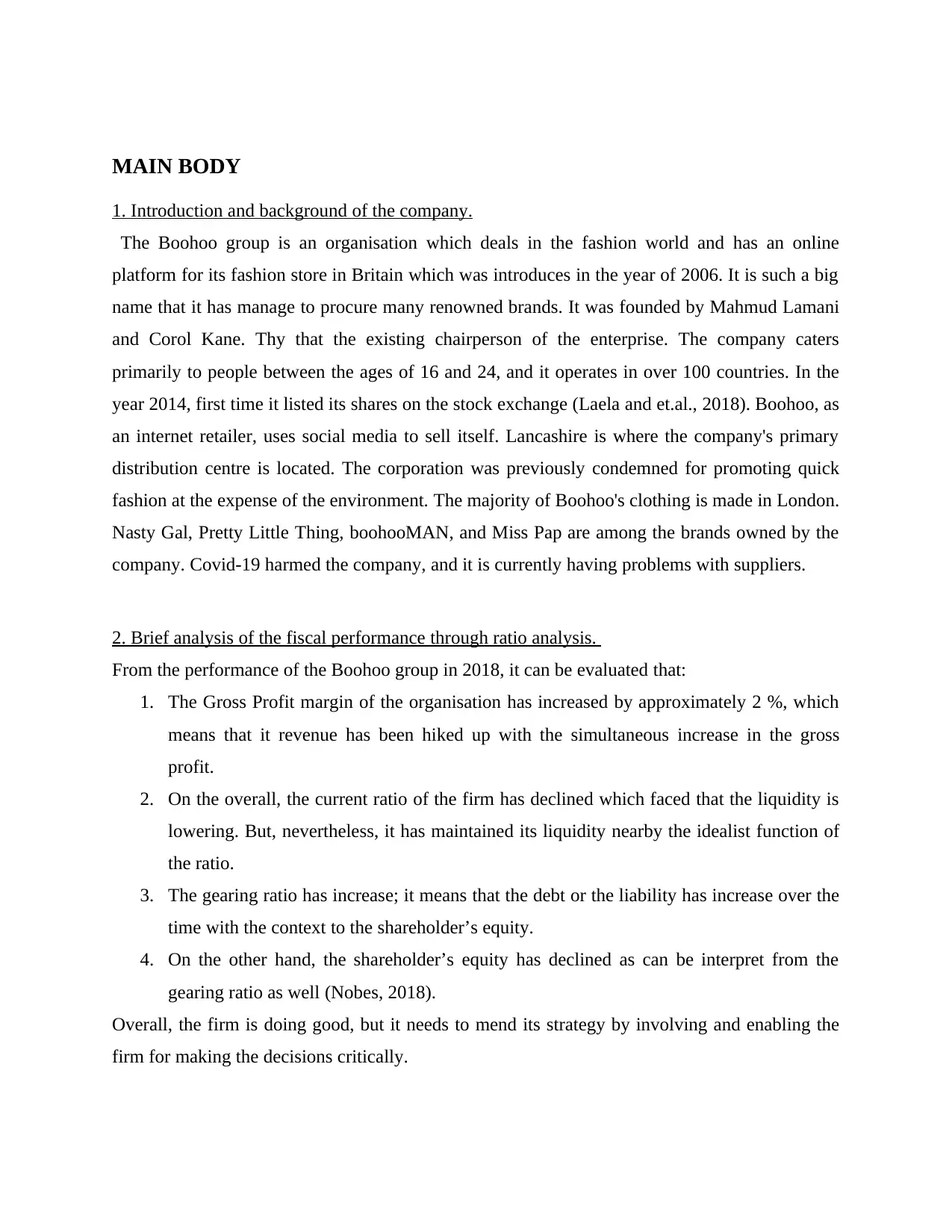
MAIN BODY
1. Introduction and background of the company.
The Boohoo group is an organisation which deals in the fashion world and has an online
platform for its fashion store in Britain which was introduces in the year of 2006. It is such a big
name that it has manage to procure many renowned brands. It was founded by Mahmud Lamani
and Corol Kane. Thy that the existing chairperson of the enterprise. The company caters
primarily to people between the ages of 16 and 24, and it operates in over 100 countries. In the
year 2014, first time it listed its shares on the stock exchange (Laela and et.al., 2018). Boohoo, as
an internet retailer, uses social media to sell itself. Lancashire is where the company's primary
distribution centre is located. The corporation was previously condemned for promoting quick
fashion at the expense of the environment. The majority of Boohoo's clothing is made in London.
Nasty Gal, Pretty Little Thing, boohooMAN, and Miss Pap are among the brands owned by the
company. Covid-19 harmed the company, and it is currently having problems with suppliers.
2. Brief analysis of the fiscal performance through ratio analysis.
From the performance of the Boohoo group in 2018, it can be evaluated that:
1. The Gross Profit margin of the organisation has increased by approximately 2 %, which
means that it revenue has been hiked up with the simultaneous increase in the gross
profit.
2. On the overall, the current ratio of the firm has declined which faced that the liquidity is
lowering. But, nevertheless, it has maintained its liquidity nearby the idealist function of
the ratio.
3. The gearing ratio has increase; it means that the debt or the liability has increase over the
time with the context to the shareholder’s equity.
4. On the other hand, the shareholder’s equity has declined as can be interpret from the
gearing ratio as well (Nobes, 2018).
Overall, the firm is doing good, but it needs to mend its strategy by involving and enabling the
firm for making the decisions critically.
1. Introduction and background of the company.
The Boohoo group is an organisation which deals in the fashion world and has an online
platform for its fashion store in Britain which was introduces in the year of 2006. It is such a big
name that it has manage to procure many renowned brands. It was founded by Mahmud Lamani
and Corol Kane. Thy that the existing chairperson of the enterprise. The company caters
primarily to people between the ages of 16 and 24, and it operates in over 100 countries. In the
year 2014, first time it listed its shares on the stock exchange (Laela and et.al., 2018). Boohoo, as
an internet retailer, uses social media to sell itself. Lancashire is where the company's primary
distribution centre is located. The corporation was previously condemned for promoting quick
fashion at the expense of the environment. The majority of Boohoo's clothing is made in London.
Nasty Gal, Pretty Little Thing, boohooMAN, and Miss Pap are among the brands owned by the
company. Covid-19 harmed the company, and it is currently having problems with suppliers.
2. Brief analysis of the fiscal performance through ratio analysis.
From the performance of the Boohoo group in 2018, it can be evaluated that:
1. The Gross Profit margin of the organisation has increased by approximately 2 %, which
means that it revenue has been hiked up with the simultaneous increase in the gross
profit.
2. On the overall, the current ratio of the firm has declined which faced that the liquidity is
lowering. But, nevertheless, it has maintained its liquidity nearby the idealist function of
the ratio.
3. The gearing ratio has increase; it means that the debt or the liability has increase over the
time with the context to the shareholder’s equity.
4. On the other hand, the shareholder’s equity has declined as can be interpret from the
gearing ratio as well (Nobes, 2018).
Overall, the firm is doing good, but it needs to mend its strategy by involving and enabling the
firm for making the decisions critically.
⊘ This is a preview!⊘
Do you want full access?
Subscribe today to unlock all pages.

Trusted by 1+ million students worldwide
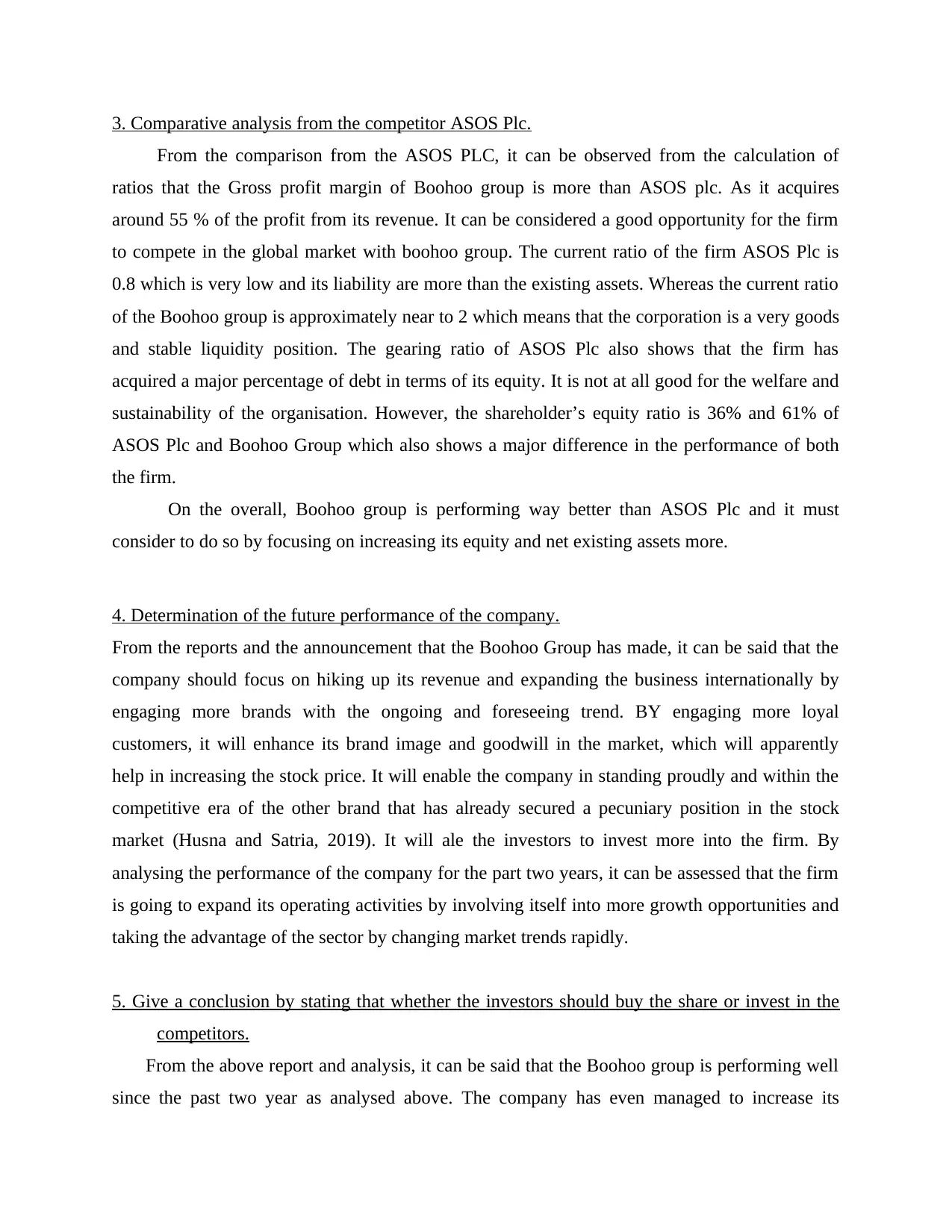
3. Comparative analysis from the competitor ASOS Plc.
From the comparison from the ASOS PLC, it can be observed from the calculation of
ratios that the Gross profit margin of Boohoo group is more than ASOS plc. As it acquires
around 55 % of the profit from its revenue. It can be considered a good opportunity for the firm
to compete in the global market with boohoo group. The current ratio of the firm ASOS Plc is
0.8 which is very low and its liability are more than the existing assets. Whereas the current ratio
of the Boohoo group is approximately near to 2 which means that the corporation is a very goods
and stable liquidity position. The gearing ratio of ASOS Plc also shows that the firm has
acquired a major percentage of debt in terms of its equity. It is not at all good for the welfare and
sustainability of the organisation. However, the shareholder’s equity ratio is 36% and 61% of
ASOS Plc and Boohoo Group which also shows a major difference in the performance of both
the firm.
On the overall, Boohoo group is performing way better than ASOS Plc and it must
consider to do so by focusing on increasing its equity and net existing assets more.
4. Determination of the future performance of the company.
From the reports and the announcement that the Boohoo Group has made, it can be said that the
company should focus on hiking up its revenue and expanding the business internationally by
engaging more brands with the ongoing and foreseeing trend. BY engaging more loyal
customers, it will enhance its brand image and goodwill in the market, which will apparently
help in increasing the stock price. It will enable the company in standing proudly and within the
competitive era of the other brand that has already secured a pecuniary position in the stock
market (Husna and Satria, 2019). It will ale the investors to invest more into the firm. By
analysing the performance of the company for the part two years, it can be assessed that the firm
is going to expand its operating activities by involving itself into more growth opportunities and
taking the advantage of the sector by changing market trends rapidly.
5. Give a conclusion by stating that whether the investors should buy the share or invest in the
competitors.
From the above report and analysis, it can be said that the Boohoo group is performing well
since the past two year as analysed above. The company has even managed to increase its
From the comparison from the ASOS PLC, it can be observed from the calculation of
ratios that the Gross profit margin of Boohoo group is more than ASOS plc. As it acquires
around 55 % of the profit from its revenue. It can be considered a good opportunity for the firm
to compete in the global market with boohoo group. The current ratio of the firm ASOS Plc is
0.8 which is very low and its liability are more than the existing assets. Whereas the current ratio
of the Boohoo group is approximately near to 2 which means that the corporation is a very goods
and stable liquidity position. The gearing ratio of ASOS Plc also shows that the firm has
acquired a major percentage of debt in terms of its equity. It is not at all good for the welfare and
sustainability of the organisation. However, the shareholder’s equity ratio is 36% and 61% of
ASOS Plc and Boohoo Group which also shows a major difference in the performance of both
the firm.
On the overall, Boohoo group is performing way better than ASOS Plc and it must
consider to do so by focusing on increasing its equity and net existing assets more.
4. Determination of the future performance of the company.
From the reports and the announcement that the Boohoo Group has made, it can be said that the
company should focus on hiking up its revenue and expanding the business internationally by
engaging more brands with the ongoing and foreseeing trend. BY engaging more loyal
customers, it will enhance its brand image and goodwill in the market, which will apparently
help in increasing the stock price. It will enable the company in standing proudly and within the
competitive era of the other brand that has already secured a pecuniary position in the stock
market (Husna and Satria, 2019). It will ale the investors to invest more into the firm. By
analysing the performance of the company for the part two years, it can be assessed that the firm
is going to expand its operating activities by involving itself into more growth opportunities and
taking the advantage of the sector by changing market trends rapidly.
5. Give a conclusion by stating that whether the investors should buy the share or invest in the
competitors.
From the above report and analysis, it can be said that the Boohoo group is performing well
since the past two year as analysed above. The company has even managed to increase its
Paraphrase This Document
Need a fresh take? Get an instant paraphrase of this document with our AI Paraphraser
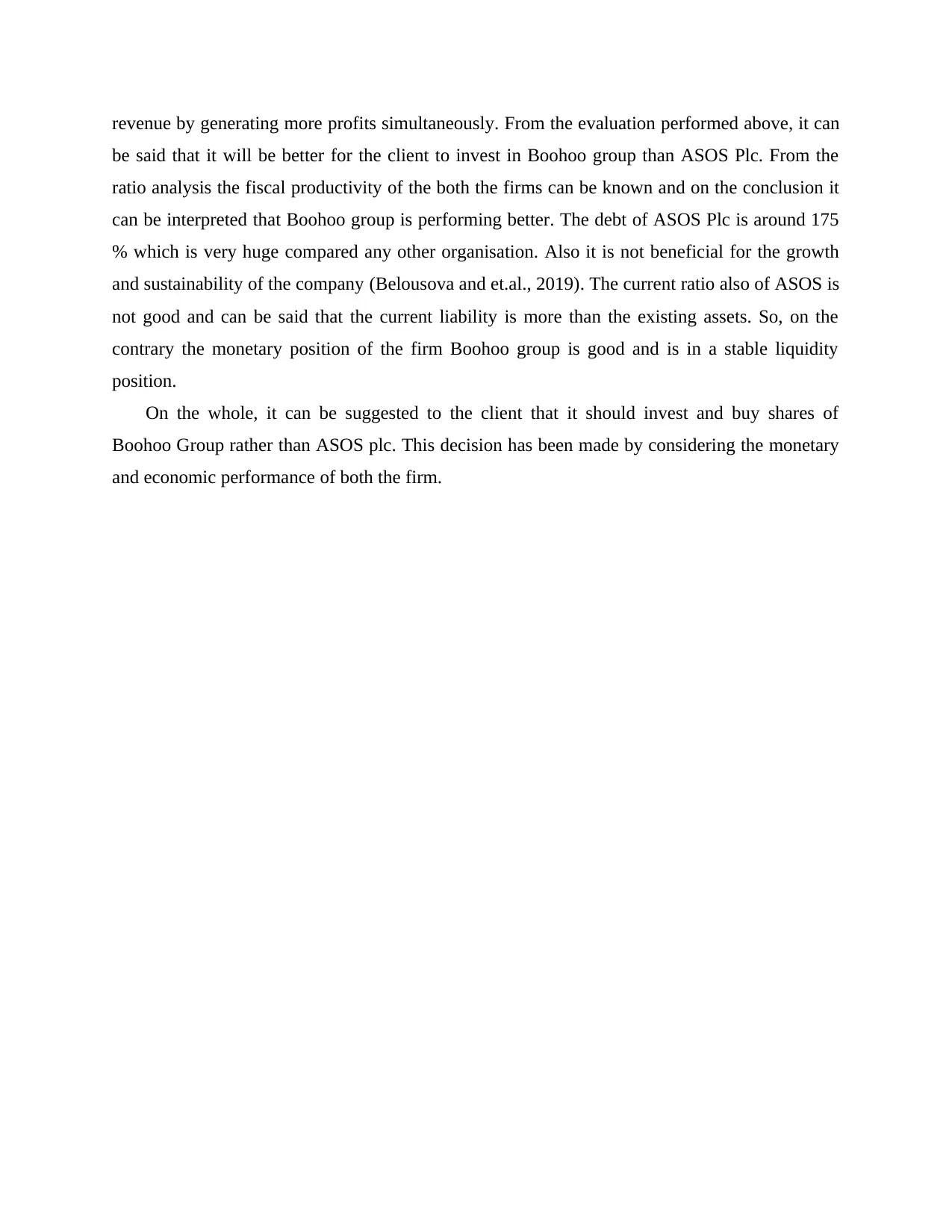
revenue by generating more profits simultaneously. From the evaluation performed above, it can
be said that it will be better for the client to invest in Boohoo group than ASOS Plc. From the
ratio analysis the fiscal productivity of the both the firms can be known and on the conclusion it
can be interpreted that Boohoo group is performing better. The debt of ASOS Plc is around 175
% which is very huge compared any other organisation. Also it is not beneficial for the growth
and sustainability of the company (Belousova and et.al., 2019). The current ratio also of ASOS is
not good and can be said that the current liability is more than the existing assets. So, on the
contrary the monetary position of the firm Boohoo group is good and is in a stable liquidity
position.
On the whole, it can be suggested to the client that it should invest and buy shares of
Boohoo Group rather than ASOS plc. This decision has been made by considering the monetary
and economic performance of both the firm.
be said that it will be better for the client to invest in Boohoo group than ASOS Plc. From the
ratio analysis the fiscal productivity of the both the firms can be known and on the conclusion it
can be interpreted that Boohoo group is performing better. The debt of ASOS Plc is around 175
% which is very huge compared any other organisation. Also it is not beneficial for the growth
and sustainability of the company (Belousova and et.al., 2019). The current ratio also of ASOS is
not good and can be said that the current liability is more than the existing assets. So, on the
contrary the monetary position of the firm Boohoo group is good and is in a stable liquidity
position.
On the whole, it can be suggested to the client that it should invest and buy shares of
Boohoo Group rather than ASOS plc. This decision has been made by considering the monetary
and economic performance of both the firm.
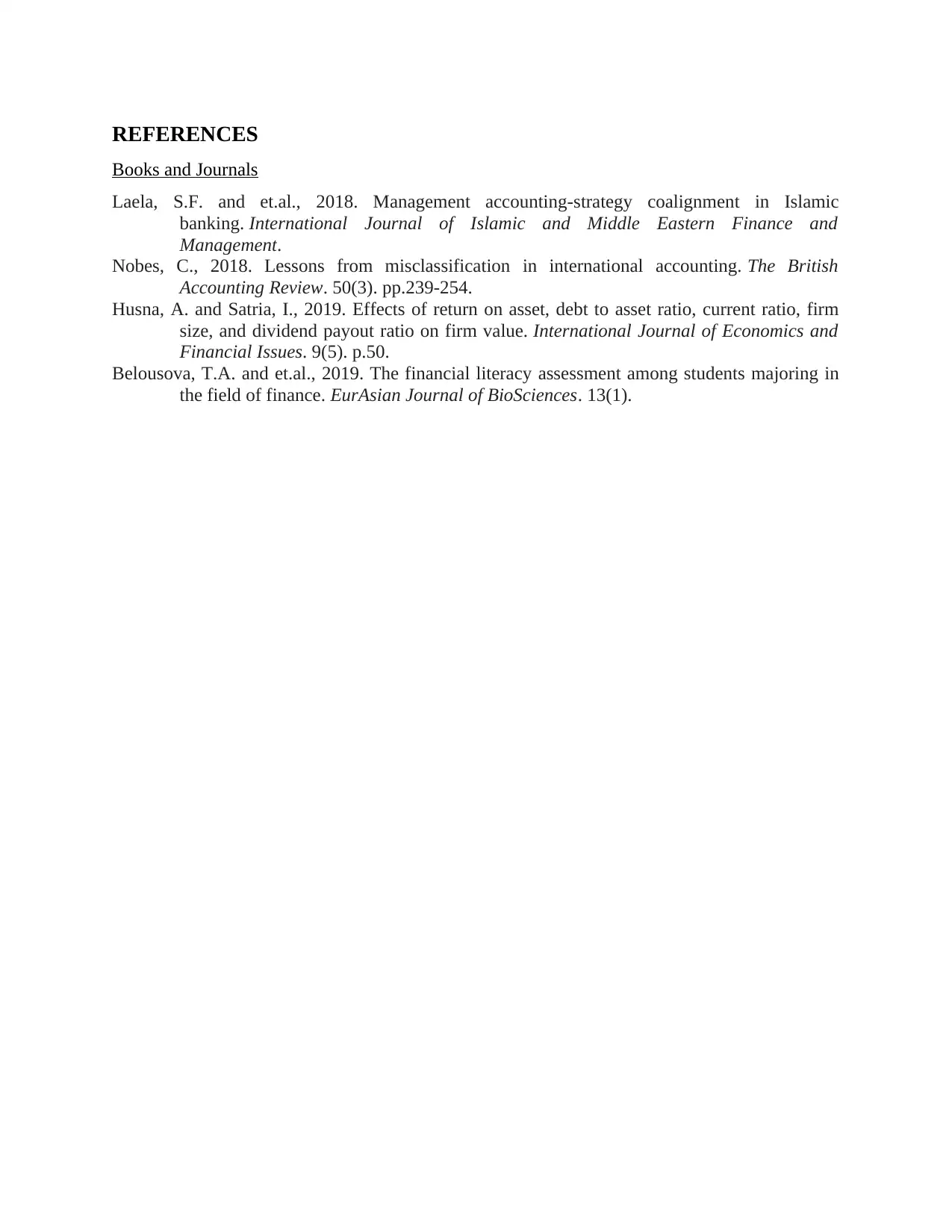
REFERENCES
Books and Journals
Laela, S.F. and et.al., 2018. Management accounting-strategy coalignment in Islamic
banking. International Journal of Islamic and Middle Eastern Finance and
Management.
Nobes, C., 2018. Lessons from misclassification in international accounting. The British
Accounting Review. 50(3). pp.239-254.
Husna, A. and Satria, I., 2019. Effects of return on asset, debt to asset ratio, current ratio, firm
size, and dividend payout ratio on firm value. International Journal of Economics and
Financial Issues. 9(5). p.50.
Belousova, T.A. and et.al., 2019. The financial literacy assessment among students majoring in
the field of finance. EurAsian Journal of BioSciences. 13(1).
Books and Journals
Laela, S.F. and et.al., 2018. Management accounting-strategy coalignment in Islamic
banking. International Journal of Islamic and Middle Eastern Finance and
Management.
Nobes, C., 2018. Lessons from misclassification in international accounting. The British
Accounting Review. 50(3). pp.239-254.
Husna, A. and Satria, I., 2019. Effects of return on asset, debt to asset ratio, current ratio, firm
size, and dividend payout ratio on firm value. International Journal of Economics and
Financial Issues. 9(5). p.50.
Belousova, T.A. and et.al., 2019. The financial literacy assessment among students majoring in
the field of finance. EurAsian Journal of BioSciences. 13(1).
⊘ This is a preview!⊘
Do you want full access?
Subscribe today to unlock all pages.

Trusted by 1+ million students worldwide

Paraphrase This Document
Need a fresh take? Get an instant paraphrase of this document with our AI Paraphraser

1 out of 8
Related Documents
Your All-in-One AI-Powered Toolkit for Academic Success.
+13062052269
info@desklib.com
Available 24*7 on WhatsApp / Email
![[object Object]](/_next/static/media/star-bottom.7253800d.svg)
Unlock your academic potential
Copyright © 2020–2025 A2Z Services. All Rights Reserved. Developed and managed by ZUCOL.




